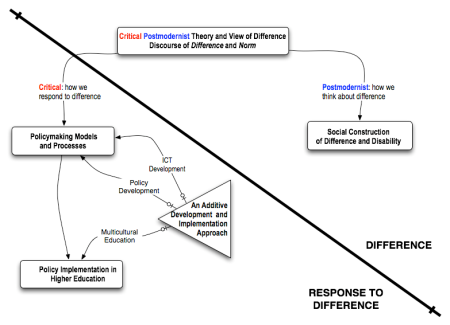This study introduces a theoretical construct informed by a discourse of difference and norm, using a critical lens of policy implementation theories and a postmodernist lens inspired by the social model of disability (Goggin & Newell, 2000; Marks, 1997; Oliver, 1990; Oliver 1996). The construct frames Web accessibility policy within a multifaceted additive approach, which reveals itself in disability policymaking, in development of ICTs, in multicultural education and other practices in higher education.

Theoretical construct: A critical postmodernist view of difference
Critical and postmodernist theories do not necessarily reflect opposite approaches. Addressing matters of difference in higher education, Tierney (1993) asserted that it is helpful to combine these theoretical schemas and use them together as a framework to generate change: “Critical theory’s advocacy for empowerment and the development of voice for the oppressed needs to be defused with postmodern notion of difference” (p. 10).
Thus, the critical portion of the critical postmodernist framework asks ‘what can be done to understand difference’ and generate actual change, and the postmodernist portion of the critical postmodernist approach asks ‘how we can change the way that difference is thought of’. Gioroux (1990) offered another rationale for connecting the two approaches. He claimed that one must not separate rights from their everyday life implementation and use, since the issue is not about one’s understanding of the other, but rather one’s involvement in the construction of the other. Griffin, et al. (2007) further clarified this issue when arguing that normality is defined so narrowly that it becomes disabling; thus, critical approaches need a wide postmodernist understanding to generate the change they seek.
Leave a comment